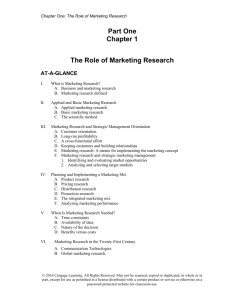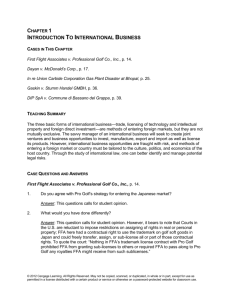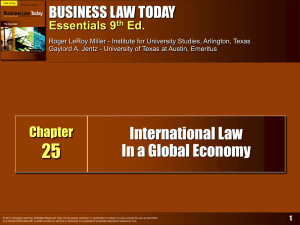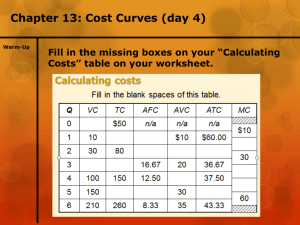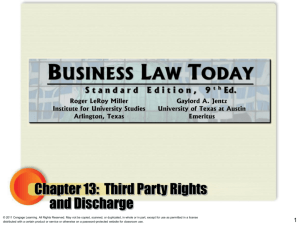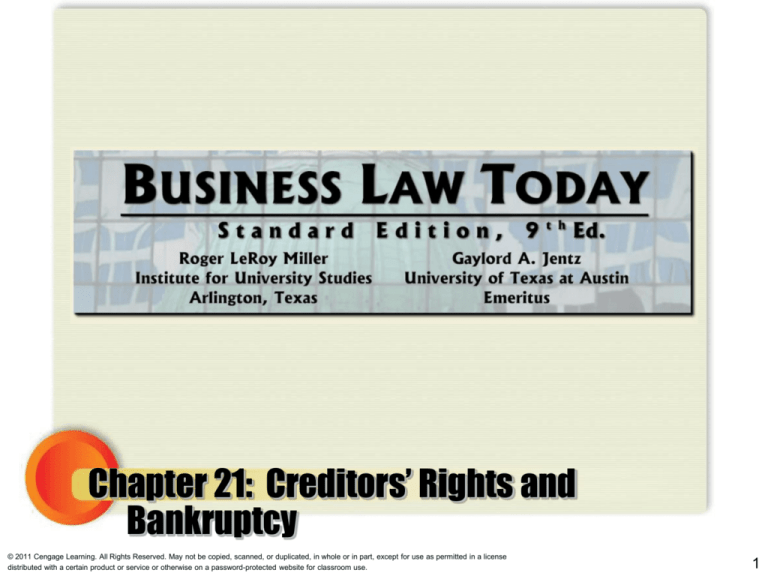
Chapter 21: Creditors’ Rights and
Bankruptcy
© 2011 Cengage Learning. All Rights Reserved. May not be copied, scanned, or duplicated, in whole or in part, except for use as permitted in a license
distributed with a certain product or service or otherwise on a password-protected website for classroom use.
1
Learning Objectives
• What is prejudgment attachment? Writ of
execution? How does a creditor use these
remedies?
• What is garnishment? When might a creditor
undertake a garnishment proceeding?
• In a bankruptcy proceeding, what constitutes
the debtor’s estate in property? What property
is exempt under federal bankruptcy law?
• What is the difference between an exception to
discharge and objection to discharge?
• In a Chapter 11 reorganization, what is the role
of the debtor in possession?
© 2011 Cengage Learning. All Rights Reserved. May not be copied, scanned, or duplicated, in whole or in part, except for use as permitted in
a license distributed with a certain product or service or otherwise on a password-protected website for classroom use.
2
Laws Assisting Creditors
• Liens:
– Mechanic’s Lien (real property).
– Artisan’ Lien (personal property).
– Innkeeper’s Lien (baggage of guests).
– Judicial Lien:
• Attachment: court-ordered seizure of
property.
• Writ of Execution: court-ordered sale.
© 2011 Cengage Learning. All Rights Reserved. May not be copied, scanned, or duplicated, in whole or in part, except for use as permitted in
a license distributed with a certain product or service or otherwise on a password-protected website for classroom use.
3
Laws Assisting Creditors
• Garnishment.
– Creditor permitted to collect a debt by
seizing property held by third party
(usually wages held by debtor’s
employer).
• Creditors’ Composition
Agreements: liquidated debts.
© 2011 Cengage Learning. All Rights Reserved. May not be copied, scanned, or duplicated, in whole or in part, except for use as permitted in
a license distributed with a certain product or service or otherwise on a password-protected website for classroom use.
4
Laws Assisting Creditors
• Mortgage Foreclosure.
– Creditor (mortgagee) has the right to
foreclose on property upon debtor’s
(mortgagor) default.
© 2011 Cengage Learning. All Rights Reserved. May not be copied, scanned, or duplicated, in whole or in part, except for use as permitted in
a license distributed with a certain product or service or otherwise on a password-protected website for classroom use.
5
Suretyship & Guaranty
• Third person promises to pay debt
owed by another.
© 2011 Cengage Learning. All Rights Reserved. May not be copied, scanned, or duplicated, in whole or in part, except for use as permitted in
a license distributed with a certain product or service or otherwise on a password-protected website for classroom use.
6
Suretyship & Guaranty
• Third person promises to pay debt
owed by another.
– Surety (3rd person is primarily liable).
– Guaranty (3rd person is secondarily liable).
• Must be in writing unless the “main purpose” of
the guaranty is to personally benefit the
guarantor.
Case 21.1 Capital Color Printing, Inc. v.
Ahern.
Document satisfied Statute of Frauds, identified Quality
Printing as the customer with a signed personal guaranty.
© 2011 Cengage Learning. All Rights Reserved. May not be copied, scanned, or duplicated, in whole or in part, except for use as permitted in
a license distributed with a certain product or service or otherwise on a password-protected website for classroom use.
7
Suretyship & Guaranty
• Actions that Release the Surety and
Guarantor.
• Defenses of Surety and Guarantor:
– Can assert any defense of principal debtor
except debtor’s incapacity or bankruptcy
(which are personal to debtor).
• Rights of Surety and Guarantor:
– Subrogation.
– Reimbursement (from debtor).
– Contribution.
© 2011 Cengage Learning. All Rights Reserved. May not be copied, scanned, or duplicated, in whole or in part, except for use as permitted in
a license distributed with a certain product or service or otherwise on a password-protected website for classroom use.
8
Laws Assisting Debtors
• Homestead Exemption.
– Family home free from claims of unsecured
creditors or trustees in bankruptcy.
• Other Exemptions:
– Household furniture.
– Clothing and personal possessions.
– Vehicle.
– Tools of the trade.
© 2011 Cengage Learning. All Rights Reserved. May not be copied, scanned, or duplicated, in whole or in part, except for use as permitted in
a license distributed with a certain product or service or otherwise on a password-protected website for classroom use.
9
Bankruptcy Proceedings
• Article I, Section 8 of the U.S.
Constitution. Federal jurisdiction.
• Bankruptcy Reform Act of 2005
significant modified bankruptcy laws.
• Federal Bankruptcy Courts under U.S.
district courts, can appeal to district
courts.
• Federally appointed judges.
© 2011 Cengage Learning. All Rights Reserved. May not be copied, scanned, or duplicated, in whole or in part, except for use as permitted in
a license distributed with a certain product or service or otherwise on a password-protected website for classroom use.
10
Types of Bankruptcy Relief
• Bankruptcy provides different
relief:
– Chapter 7: Liquidation.
– Chapter 11: Corporate Reorganizations.
– Chapter 12: Family Farmers.
– Chapter 13: Adjustment of Individuals’
Debts with a payment plan.
• Special Treatment of ConsumerDebtors.
© 2011 Cengage Learning. All Rights Reserved. May not be copied, scanned, or duplicated, in whole or in part, except for use as permitted in
a license distributed with a certain product or service or otherwise on a password-protected website for classroom use.
11
Chapter 7 - Liquidation
• Any person (including corporation) can
file.
• All debts are liquidated (discharged).
• Begins with a voluntary or involuntary
Filing of a Petition (Automatic Stay).
– Voluntary: filed by debtor.
– Involuntary: creditors force debtor to file.
– 2005 Act: Debtors must go through
counseling with approved nonprofit agency
during the 180 days prior to filing.
© 2011 Cengage Learning. All Rights Reserved. May not be copied, scanned, or duplicated, in whole or in part, except for use as permitted in
a license distributed with a certain product or service or otherwise on a password-protected website for classroom use.
12
Chapter 7
• 2005 Act: Attorney must file affidavit
explaining other chapters available to
debtor.
• 2005 Act: Attorney must make reasonable
attempt to verify accuracy of petition and
schedules. Failure to do so could be
perjury.
– List secured and unsecured creditors and addresses
and amount of money owed. List of all property owned
including property claimed; current income and
expenses.
– Swear to these and sign. Federal crime to
misrepresent.
© 2011 Cengage Learning. All Rights Reserved. May not be copied, scanned, or duplicated, in whole or in part, except for use as permitted in
a license distributed with a certain product or service or otherwise on a password-protected website for classroom use.
13
2005: Substantial Abuse
• Under 2005 Act, Substantial Abuse will
Be Presumed If:
– Based on “Means Testing” debtor’s family
income is greater than state median income.
– Creditors have standing to dismiss petition.
• Substantial Will NOT be Presumed If:
– Based on “Means Testing” debtor’s family
income is less than state median income.
– But creditors have no standing to dismiss.
• Order for Relief.
© 2011 Cengage Learning. All Rights Reserved. May not be copied, scanned, or duplicated, in whole or in part, except for use as permitted in
a license distributed with a certain product or service or otherwise on a password-protected website for classroom use.
14
Chapter 7 – Involuntary
• Occurs when debtor’s creditors force
debtor into bankruptcy proceedings.
• Can occur if:
– If debtor has twelve or more creditors, three
or more with claims totaling $13,475, or
– If debtor has twelve or more creditors, one
has a claim totaling $13,475.
© 2011 Cengage Learning. All Rights Reserved. May not be copied, scanned, or duplicated, in whole or in part, except for use as permitted in
a license distributed with a certain product or service or otherwise on a password-protected website for classroom use.
15
Automatic Stay
• Automatic Stay upon Filing either
Voluntary or Involuntary Petition.
• Creditors cannot commence or
continue most legal actions.
• Damages for violation of stay.
Case 21.2 In re Kuehn.
Kuehn owed $6,000 in tuition and filed bankruptcy.
University’s refusal to provide transcript, unless she paid
the tuition, violates automatic stay.
© 2011 Cengage Learning. All Rights Reserved. May not be copied, scanned, or duplicated, in whole or in part, except for use as permitted in
a license distributed with a certain product or service or otherwise on a password-protected website for classroom use.
16
Automatic Stay
• Exceptions to Automatic Stay:
– Collection can continue for domestic-support
obligations.
– Proceedings against debtor in divorce, domestic
violence can continue.
– Investigations by securities enforcement are not
stayed.
• Limitations on Automatic Stay:
– Creditors can get “adequate protection.”
– Periodic or one time cash payments or equivalent.
– Reaffirmation.
© 2011 Cengage Learning. All Rights Reserved. May not be copied, scanned, or duplicated, in whole or in part, except for use as permitted in
a license distributed with a certain product or service or otherwise on a password-protected website for classroom use.
17
Property of the Estate
• Debtor’s Estate includes:
– All Debtor’s legal and equitable interests in
property presently held, including community
property,
– Property transferred in a “voidable”
transaction, and
– Property which Debtor becomes entitled
within 180 days after filing.
© 2011 Cengage Learning. All Rights Reserved. May not be copied, scanned, or duplicated, in whole or in part, except for use as permitted in
a license distributed with a certain product or service or otherwise on a password-protected website for classroom use.
18
Property of the Estate
• Estate includes (cont’d):
– Proceeds and profits from the property of the
estate.
– After-acquired property such as inheritances,
property settlements, and life insurance
death proceeds.
© 2011 Cengage Learning. All Rights Reserved. May not be copied, scanned, or duplicated, in whole or in part, except for use as permitted in
a license distributed with a certain product or service or otherwise on a password-protected website for classroom use.
19
Creditors’ Meeting and Claims
• Ten to thirty days after filing, Court
calls meeting of creditors. Debtor is
examined under oath about his debts
and assets.
• Within 90 days, Creditors must file
“proof of claim” with court clerk.
• Leases cannot be for more than one
year.
© 2011 Cengage Learning. All Rights Reserved. May not be copied, scanned, or duplicated, in whole or in part, except for use as permitted in
a license distributed with a certain product or service or otherwise on a password-protected website for classroom use.
20
Creditors’ Meeting and Claims
• Allowed unless disputed.
• If claim is disputed or unliquidated,
court will decide value.
• It is a crime to file false claim.
• Employment contracts and real estate.
© 2011 Cengage Learning. All Rights Reserved. May not be copied, scanned, or duplicated, in whole or in part, except for use as permitted in
a license distributed with a certain product or service or otherwise on a password-protected website for classroom use.
21
Exemptions
• Up to $20,200 in home equity.
• Up to $3,225 in car.
• Up to $10,775 in personal possessions (up to
$525 per item).
• Up to $1,350 in jewelry.
• Up to $2,025 in tools.
• Social security, alimony and support
payments.
• Up to $20,200 in personal injury awards.
• 2005 Act: Homestead Exemption.
– Debtor must have lived in state two years.
– Up to $136,875 of equity.
© 2011 Cengage Learning. All Rights Reserved. May not be copied, scanned, or duplicated, in whole or in part, except for use as permitted in
a license distributed with a certain product or service or otherwise on a password-protected website for classroom use.
22
Trustee’s Powers
• Court-appointed until first meeting of
creditors.
• Creditors elect permanent trustee
• Administers estate.
• Collects proceeds, liquidates assets
and pay Creditors in order of priority.
© 2011 Cengage Learning. All Rights Reserved. May not be copied, scanned, or duplicated, in whole or in part, except for use as permitted in
a license distributed with a certain product or service or otherwise on a password-protected website for classroom use.
23
Trustee Rights and Duties
• New Duties under the 2005 Bankruptcy
Reform Act:
– Promptly review all materials filed by debtor.
– Not later than 40 days after filing, Trustee
must file: a motion to dismiss the case,
change to Chapter 13, or why motion would
not be appropriate.
– New duties to protect domestic-support
obligations.
© 2011 Cengage Learning. All Rights Reserved. May not be copied, scanned, or duplicated, in whole or in part, except for use as permitted in
a license distributed with a certain product or service or otherwise on a password-protected website for classroom use.
24
Trustee Rights and Duties
• Right to Possession of Debtor’s Property.
– Constructive Possession (change lock on door).
• Avoidance Powers.
– Trustee can set aside a sale or transfer of debtor’s
property (2005 Act: cannot avoid bona fide
domestic support debt).
• Voidable Rights.
– Trustee can stand in shoes of debtor and assert
any lack of capacity or lack of assent.
© 2011 Cengage Learning. All Rights Reserved. May not be copied, scanned, or duplicated, in whole or in part, except for use as permitted in
a license distributed with a certain product or service or otherwise on a password-protected website for classroom use.
25
Preferences
• A Debtor is not permitted to transfer
property or make a payment that favors—
or gives a preference to—one creditor
over another.
• For a Trustee to recover preferential
payment, Debtor must be insolvent and
transferred property for pre-existing debt
within previous 90 days.
• 2005 Act: permits consumer-debtor to
transfer any property to creditor up to
$5,475.
© 2011 Cengage Learning. All Rights Reserved. May not be copied, scanned, or duplicated, in whole or in part, except for use as permitted in
a license distributed with a certain product or service or otherwise on a password-protected website for classroom use.
26
Preferences
• Trustee can use preferential payment to
pay a real preexisting debt, not for
current consideration.
• Creditor gets more than he would in a
Chapter 7.
• Consumer can transfer up to $5,000
without constituting a preference.
• Domestic-support debts are not
preferences.
© 2011 Cengage Learning. All Rights Reserved. May not be copied, scanned, or duplicated, in whole or in part, except for use as permitted in
a license distributed with a certain product or service or otherwise on a password-protected website for classroom use.
27
Other Trustee Powers
• Trustee can avoid statutory liens that
became effective when bankruptcy
petition filed, or when debtor became
insolvent.
• Can avoid liens which were unperfected
on date of bankruptcy.
• Fraudulent Transfers:
– Trustee may avoid fraudulent transfers made
within one year of filing of petition.
– Trustee may proceed under state law for fraud
with a 3 year statute of limitations.
© 2011 Cengage Learning. All Rights Reserved. May not be copied, scanned, or duplicated, in whole or in part, except for use as permitted in
a license distributed with a certain product or service or otherwise on a password-protected website for classroom use.
28
Distribution of Property
© 2011 Cengage Learning. All Rights Reserved. May not be copied, scanned, or duplicated, in whole or in part, except for use as permitted in
a license distributed with a certain product or service or otherwise on a password-protected website for classroom use.
29
Distribution of Property
• If Secured Creditors:
– Consumer debtors.
• Have 30 days from filing petition or before first
meeting of creditors.
• Debtor must tell what she intends to do with
collateral-- keep or surrender.
• Trustee must enforce within 45 days.
– If surrenders: creditor can keep or sell.
• If creditor keeps = full satisfaction of debt.
• If creditor sells = can use extra for costs, or can
become unsecured creditor for deficiency.
© 2011 Cengage Learning. All Rights Reserved. May not be copied, scanned, or duplicated, in whole or in part, except for use as permitted in
a license distributed with a certain product or service or otherwise on a password-protected website for classroom use.
30
Distribution to Unsecured Creditors
• Unsecured property:
– Paid according to bankruptcy law.
– All of one class must be paid before moving
to next.
– Creditor within last class receive
proportionately if not enough.
– See Priority List in text.
– All creditors paid, trustee gives extra back to
debtor.
© 2011 Cengage Learning. All Rights Reserved. May not be copied, scanned, or duplicated, in whole or in part, except for use as permitted in
a license distributed with a certain product or service or otherwise on a password-protected website for classroom use.
31
Chapter 7-Discharge
•
•
•
•
•
Exceptions.
Objections to Discharge.
Effect of Discharge.
Revocation of Discharge.
Reaffirmation of a Debt.
© 2011 Cengage Learning. All Rights Reserved. May not be copied, scanned, or duplicated, in whole or in part, except for use as permitted in
a license distributed with a certain product or service or otherwise on a password-protected website for classroom use.
32
Exceptions to Discharge
• Claims for back taxes.
• Claims for amounts borrowed by Debtor to
pay federal taxes.
• Claims against property/money obtained by
Debtor under false pretenses.
• Claims by Creditors who did not know about
bankruptcy.
• Student Loans.
Case 21.3 Mosely.
Federal student loans cannot be discharged absent a
showing of undue hardship. Mosely proved undue
hardship by showing physical and emotion problems.
© 2011 Cengage Learning. All Rights Reserved. May not be copied, scanned, or duplicated, in whole or in part, except for use as permitted in
a license distributed with a certain product or service or otherwise on a password-protected website for classroom use.
33
Objections to Discharge
• Bankruptcy may also deny the
discharge of the debtor (not the debt):
– If debtor intentional concealment or
destruction of property or financial records.
– Granting of discharge within 8 years of
previous bankruptcy discharge.
– Debtor’s failure to complete credit counseling
courses.
– Debtor found guilty of felony.
• Revocation of Discharge.
© 2011 Cengage Learning. All Rights Reserved. May not be copied, scanned, or duplicated, in whole or in part, except for use as permitted in
a license distributed with a certain product or service or otherwise on a password-protected website for classroom use.
34
Reaffirmation of Debt
• Debtor may wish to pay a debt
notwithstanding the debt could be
discharged in bankruptcy.
• Agreement is filed with court.
• Debtor can rescind agreement at any
time before discharge.
© 2011 Cengage Learning. All Rights Reserved. May not be copied, scanned, or duplicated, in whole or in part, except for use as permitted in
a license distributed with a certain product or service or otherwise on a password-protected website for classroom use.
35
Chapter 11-Reorganization
• Debtor and Creditors formulate a plan
under which the Debtor pays a portion
of its debts and is discharged of the
rest.
• Same debtors as are eligible under
Chapter 7.
• Focus is on “Best Interests” of the
Creditors.
© 2011 Cengage Learning. All Rights Reserved. May not be copied, scanned, or duplicated, in whole or in part, except for use as permitted in
a license distributed with a certain product or service or otherwise on a password-protected website for classroom use.
36
Chapter 11-Reorganization
• “Fast track” Chapter 11 for small
business debtors whose liabilities do
no exceed $2 million and who do not
own or manage real estate.
• “Workouts” (private negotiated
settlements).
© 2011 Cengage Learning. All Rights Reserved. May not be copied, scanned, or duplicated, in whole or in part, except for use as permitted in
a license distributed with a certain product or service or otherwise on a password-protected website for classroom use.
37
Chapter 11-Reorganization
• Debtor in Possession (DIP).
– Trustee may be appointed.
– DIP has same powers as trustee in Chapter
7.
• Strong-arm clause.
• Creditors’ Committees.
© 2011 Cengage Learning. All Rights Reserved. May not be copied, scanned, or duplicated, in whole or in part, except for use as permitted in
a license distributed with a certain product or service or otherwise on a password-protected website for classroom use.
38
Chapter 11-Reorganization Plan
• Acceptance and Confirmation of the Plan.
– (2005 Act: Confirmation does not discharge a
debtor.)
– Rehabilitates debtor and conserves estate.
– Court may “cram down” plan on all creditors.
• Plan must be equitable and:
– Designate classes of claims and interests.
– Specify treatment to be afforded the classes.
– Provide adequate means for execution.
© 2011 Cengage Learning. All Rights Reserved. May not be copied, scanned, or duplicated, in whole or in part, except for use as permitted in
a license distributed with a certain product or service or otherwise on a password-protected website for classroom use.
39
Chapter 13- Individuals’ Repayment Plan
• Chapter 13: Individuals’ Repayment
Plans.
• For individuals with regular income
who owe fixed unsecured debts of
<$336,900 or fixed secured debts of
<$1,010,650.
• Not for partnerships or corporations.
© 2011 Cengage Learning. All Rights Reserved. May not be copied, scanned, or duplicated, in whole or in part, except for use as permitted in
a license distributed with a certain product or service or otherwise on a password-protected website for classroom use.
40
Chapter 13-Individuals’ Repayment Plan
• The Repayment Plan.
– For all or a portion of debts to be paid during
a period not to exceed 3 years.
– Confirmation Hearing for the Plan.
• Hearing for interested parties to object to plan.
• Court will confirm (order) the plan after creditors
approve.
– Objections to the Plan.
• Discharge balance of debt (after
completion of all payments in the plan).
© 2011 Cengage Learning. All Rights Reserved. May not be copied, scanned, or duplicated, in whole or in part, except for use as permitted in
a license distributed with a certain product or service or otherwise on a password-protected website for classroom use.
41
Chapter 12-Family Farmers and Fishermen
• Chapter 12: Family Farmer and
(Fisherman, 2005) Plans.
– “Family Farmer” (Or Fisherman): 50% of
gross income comes from farming (or fishing)
and whose debts are 80% farm (commercial
fishing) related.
– Procedure for filing.
– Content of plan.
– Court confirmation.
© 2011 Cengage Learning. All Rights Reserved. May not be copied, scanned, or duplicated, in whole or in part, except for use as permitted in
a license distributed with a certain product or service or otherwise on a password-protected website for classroom use.
42




